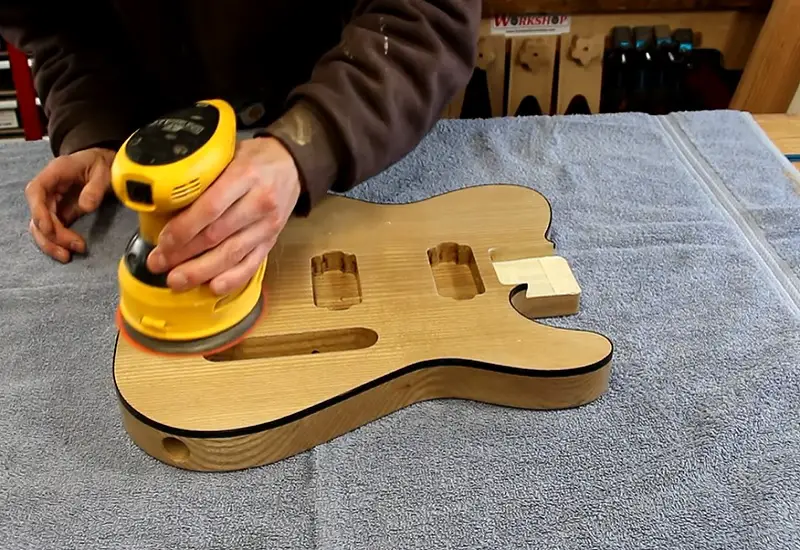Views: 17
Yes, you can use an orbital sander as a buffer for certain tasks. However, it is not ideal for all buffing applications.
When considering using an orbital sander as a buffer, it’s important to understand the limitations and potential risks involved. While an orbital sander can effectively smooth surfaces, it lacks the rotational power and specific design of a dedicated buffer.
As a result, using an orbital sander for buffing may not achieve the desired finish and could potentially damage the surface being worked on.
It is recommended to use the appropriate tool for the specific task to ensure optimal results and prevent any accidental harm.
Contents
Can I Use An Orbital Sander As A Buffer: The Ultimate Guide
Unlock the potential of your orbital sander to double as a buffer with this comprehensive guide. Learn practical tips and techniques to achieve professional-level polishing results effortlessly.
Master the art of using your orbital sander effectively for buffing tasks with ease. Understanding the Difference Between an Orbital Sander and a Buffer
When it comes to sanding and buffing surfaces, it’s essential to choose the right tools for the job. While an orbital sander and a buffer may appear similar at first glance, they have distinct differences in terms of their purpose and functionality.
An orbital sander is primarily used for sanding wood, removing old finishes, or smoothing rough surfaces. It operates in a circular motion, making small orbits while also spinning, which provides a random pattern to prevent swirl marks on the surface.
A buffer, on the other hand, is specifically designed for polishing surfaces to achieve a smooth and glossy finish. Buffers typically have a larger and softer pad compared to orbital sanders, allowing them to distribute polishing compounds evenly and create a high shine.
Choosing The Right Tools For The Job
When deciding between an orbital sander and a buffer, it’s crucial to assess the task at hand. If you need to sand or remove old finishes, an orbital sander is the appropriate choice.
However, if your goal is to achieve a professional-grade polished finish, a buffer is the tool you’ll want to use.
Consider the nature of the surface you’re working on, the desired outcome, and the type of material you’re buffing or sanding. By understanding the specific requirements of each job, you can make an informed decision and select the right tool for the task.
Preparing The Surface For Buffing
Before using an orbital sander as a buffer, proper surface preparation is crucial to achieve optimal results.
Start by cleaning the surface thoroughly to remove any dirt, dust, or debris. You may also need to sand the surface using a lower grit sandpaper to smooth out imperfections or remove any old finishes.
Using An Orbital Sander As A Buffer
While an orbital sander is not designed for buffing, it is possible to use it as a buffer with some modifications. To do this, you’ll need to attach a buffing pad or bonnet to the sander, which can usually be found at hardware or automotive stores.
The pad should be specifically designed for buffing and polishing purposes. When using an orbital sander as a buffer, it’s important to keep a few things in mind.
First, ensure that the pad is securely attached to the sander to prevent any accidents or damage.
Second, apply a polishing compound or wax onto the pad before starting the buffing process. Lastly, use the sander at a low speed and with light pressure to avoid damaging the surface or creating swirl marks.
Techniques For Buffing With An Orbital Sander
When using an orbital sander as a buffer, it’s essential to employ proper techniques to achieve professional-looking results.
Start by moving the sander in smooth, overlapping motions, working in small sections at a time. Apply even pressure and let the sander do the work, avoiding the temptation to press too hard.
Regularly check the pad to ensure it’s still in good condition and not clogged with polishing compound or debris.
If needed, clean or replace the pad to maintain optimal performance. Additionally, wipe away any excess compound or wax from the surface using a clean cloth.
Potential Risks And Limitations
Although using an orbital sander as a buffer can be a viable option, it’s important to note the potential risks and limitations.
Since orbital sanders are not designed specifically for buffing, they may not provide the same results as a dedicated buffer.
The smaller pad size and random motion may limit the effectiveness of the buffing process, resulting in a less refined finish. Furthermore, using an orbital sander as a buffer requires caution and finesse.
Applying too much pressure or using high speeds can lead to surface damage or swirl marks. Always practice proper safety measures and be aware of the limitations of using an orbital sander for buffing purposes.
Tips For Achieving Professional-looking Results
While using an orbital sander as a buffer may have its limitations, there are several tips and techniques you can employ to achieve professional-looking results:
- Choose a high-quality polishing compound or wax that suits your specific needs.
- Ensure the surface is clean and free from any debris before starting the buffing process.
- Work in small sections, using smooth and overlapping motions.
- Regularly check the condition of the pad and clean or replace it if necessary.
- Use light pressure and low speeds to avoid surface damage or swirl marks.
By following these tips, you can enhance the effectiveness of using an orbital sander as a buffer and achieve professional-looking results.
Frequently Asked Questions For Can I Use An Orbital Sander As A Buffer
Can You Use Orbital Sander For Buffing?
Yes, you can use an orbital sander for buffing surfaces. Buffing pads can be attached to orbital sanders for polishing.
Can Sander Be Used As Buffer?
Yes, a sander can be used as a buffer for certain tasks, such as finishing and polishing surfaces.
It is important to use the correct attachment and technique for buffing to avoid damage.
Always follow safety guidelines and use appropriate pressure when using a sander as a buffer.
Can I Use My Dewalt Orbital Sander As A Polisher?
Yes, you can use your Dewalt orbital sander as a polisher for certain projects.
Is An Orbital Buffer The Same As A Sander?
No, an orbital buffer is not the same as a sander. They serve different purposes.
An orbital buffer is used for polishing and waxing vehicles, while a sander is used for smoothing surfaces and removing material.
Conclusion
Using an orbital sander as a buffer can be effective for certain tasks. However, it may not provide the same results as a dedicated buffer.
Understanding the limitations and proper techniques is key to achieving desired finishes. Experiment cautiously to find what works best for your projects.

